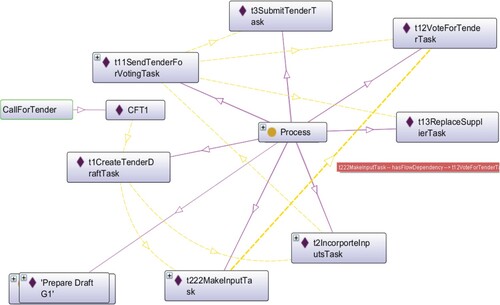Abstract
Demand shocks and fluctuations underscore the need for new approaches to coordinate collaboration between firms to scale up production. This paper proposes an approach to formalise product and process requirements via a collaboration ontology and applies semantic reasoning techniques for process formation. Our approach contributes to production research by providing flexibility in coordinating firms engaged in demand-driven collaboration. The proposed approach has four core dimensions: (1) The Collaboration ontology builds on a set of product assembly requirements, process steps, their input/output resources and semantic rules; (2) the ontology reasoner derives resource dependencies between the steps; (3) the java tool interprets resource dependencies as possible transitions in Business Process Management Notation (BPMN); (4) a workflow engine executes the generated product assembly process. The approach and the ontology were validated in an industrial aerospace tendering scenario demonstrating its practical relevance for firms seeking demand-driven collaborations to react to production changes. Finally, we position and explain our contributions to the body of knowledge in collaborative production engineering.
1. Introduction
European low-volume high-variability manufacturing industries, such as aerospace manufacturing, contend with demand fluctuations and thus increasingly seek novel ways to support demand-driven collaboration between the supplying firms. During the last 15 years of production and supply chain transformation, Airbus has reduced direct supply relationships with more than 6,000 multi-tier suppliers in favour of risk-sharing partners (Bernhard et al. Citation2007; Janke et al. Citation2007; Rossen et al. Citation2015), increasing reliance on large supply chain companies (system suppliers), as depicted in Figure . Small and Medium-Sized Enterprises (SMEs) in the aerospace industry are highly-specialised firms that need partnerships to deliver materials, standard parts, and support services to any supply chain tier (SCE Citation2017). However, they often cannot act as suppliers due to capacity or capability constraints and must form partnerships to bid for work (Schirrmann and Drat Citation2018). SMEs increasingly look for new collaborations to get more work; however, the inertia of established buyer-supplier relationships and process challenges associated with integrating new companies into a supply chain pose steep barriers for SMEs to join new demand-driven collaboration opportunities (Schirrmann and Drat Citation2018; Turkina, Van Assche, and Kali Citation2016). Particularly, SMEs perceive factors impeding data sharing and coordination as significant roadblocks to demand-driven collaboration (Kazantsev et al. Citation2022). To tackle some of the stated challenges, this paper studies the application of semantic technologies, such as ontologies and automated reasoning, to facilitate process formation and coordination of demand-driven collaborations between supplier firms and help larger firms to scale up their production capacities. We position our research (including the semantic model and its implementation) as a contribution towards supporting the transition between a centralised and a distributed supply chain setting and developing artefacts to support SMEs to fully engage in future distributed supply chains, as illustrated in Figure . We used the European Aerospace industry development as a context for this investigation. In particular, we worked on two large-scale projects: Decentralised Agile Coordination Across Supply ChainsFootnote1 (2016–2019), and European Connected Factory Platform for Agile ManufacturingFootnote2 (2019–2022), in a research partnership with the largest supplier cluster to Airbus — The HANSE Aerospace cluster.Footnote3
Figure 1. The changes in the aerospace industry require ontological support for demand-driven collaborations.
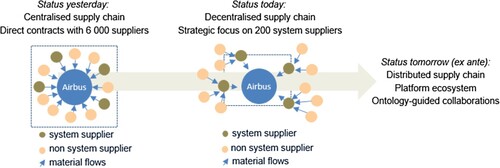
Our work on demand-driven collaboration contributes to the vision and research agenda of Industry 4.0 (Ivanov et al. Citation2020; Kagermann et al. Citation2013; Machado, Winroth, and Ribeiro da Silva Citation2020; Smit et al. Citation2016), in particular, in topics revolving around the integration of production processes along the entire value chain (Kagermann et al. Citation2013; Moeuf et al. Citation2018). Future industry value chain predictions envision more distributed supply structures eventually replacing hierarchical supply chains (EY Citation2020). These predictions call for eliminating barriers to demand-driven collaboration across supply chain tiers as a solution to quickly respond to the fluctuating demand for products with high quality and affordable costs. However, despite the importance of approaches to support increases in the pace of industrial transformations, few studies investigate the phenomenon of demand-driven collaboration in production management (Ivanov et al. Citation2020; Ivanov, Das, and Choi Citation2018; Ivanov, Dolgui, and Sokolov Citation2019; Olsen and Tomlin Citation2020; Tang and Veelenturf Citation2019), and even a smaller number of studies consider SMEs in the scope of other suppliers (Mittal et al. Citation2018; Moghaddam and Nof Citation2018; Panetto et al. Citation2019). These gaps underscore the importance of finding novel ways to support collaborative product assembly, engaging most supply chain participants, such as SMEs. The innovation and added value created by a long tail of small suppliers collaborating across supply chain tiers can play an essential tactical production role, for example, in fulfilling specialised low-volume jobs such as furnishing aircraft interiors tailored to a specific flag carrier; and complementing overall production capacity when dealing with sudden changes in the volume of orders (order fluctuation).
An ontology is ‘an explicit specification of a shared conceptualisation’ (Gruber Citation1995, 908). Related technologies for automated reasoning are suitable approaches to coordinate interactions between supply chain firms. However, they have not fully realised their potential in operations research compared to computer science and information systems domains. Applying knowledge representation mechanisms to manage global production networks’ complexity will become mainstream and drive productivity gains in manufacturing. The early works potential of ontological relationships and axioms to support reasoning has been a subject of renewed interest in Industry 4.0 research for automated team, product, and process composition (Cisneros-Cabrera et al. Citation2021; Liu et al. Citation2022), resource management for aerospace manufacturing (Arista et al. Citation2022), aircraft manufacturing system design (Arista et al. Citation2023) and Reconfigurable Manufacturing System design (Arista et al. Citation2023). Further semantic technologies and related tools may support the exploration of the broader field of collaboration design. The work reported in this paper tackles the following research question:
RQ: ‘How to support demand-driven collaboration using semantic technologies for manufacturing process formation and coordination?’
This paper contributes to production research with an approach to coordinate production in response to a new specific order in low-volume high-variability manufacturing, such as aerospace manufacturing. It is an extension of the conference paper Kazantsev et al. (Citation2022), which briefly presented an ontology-guided approach for coordination; and Kazantsev (Citation2022) – a PhD thesis that conceptualised the idea for supporting demand-driven SME collaborations. A key innovation of our approach is using an ontology to guide production process formation and coordination of demand-driven collaboration. First, we use a product data model, such as a Bill of Materials (BOM) (Vanderfeesten, Reijers, and Van der Aalst Citation2011), to derive product assembly requirements, such as hierarchical relationships between semi-parts, resource needs and production steps. These elements are implemented into an ontology as classes and properties. Second, we use the Web Ontology Language (OWL) and the Semantic Web Rule Language (SWRL)Footnote4 to define rules that convert resource requirements between process steps as dependencies. Third, we interpret these dependencies as potential ways to link the process steps together using the BPMN notation, such as swim lanes, tasks, logical elements, and events. Fourth, we develop a web prototypeFootnote5 to demonstrate how the derived process will serve as an input to a workflow engine. The ontology-guided approach makes production processes more transparent and flexible by guiding process assembly, which can be applied to various industries. The dimensions of the ontology-guided approach are illustrated in Figure .
Figure 2. Ontology-guided approach to process formation and coordination.

This paper is organised as follows: Section 2 presents the background of this study. Section 3 outlines the research methodology. Section 4 presents key findings, including the ontology and the approach to process formation & coordination. Section 5 summarises research results and outlines managerial implications, limitations, and future work.
2. Background and related work
2.1. Interoperability in production research
Interoperability is ‘[an] ability of systems [of companies] to understand functionalities of each other’ (Chen, Doumeingts, and Vernadat Citation2008). Earlier work focusing on interoperability for industrial production resulted in developing the European interoperability framework, followed by initiatives in the context of Industry 4.0, notably the Reference Architectural Model for Industry 4.0 — RAMI (Schweichhart Citation2016). Although interoperability is considered one of the critical principles of Industry 4.0 (Smit et al. Citation2016), the existing literature on Industry 4.0 adoption identifies interoperability as one of the critical concerns for SMEs (Kazantsev et al. Citation2018; Sampath and Hegde Citation2013). When manufacturing SMEs attempt to collaborate and form a new supply relationship, the coordination of work, the integration of processes and systems, and the compliance with industry governance rules pose new interoperability challenges. Existing workflow management and industrial process management tools are limited in their support for new ad-hoc collaborations created on demand based on rapidly changing production requirements since, in most nascent collaboration process design scenarios, the semantics of information and material flows cannot be specified in advance. A key interoperability challenge is enabling partners’ information systems to process and infer meaning from the business collaboration concepts (e.g. client, product, semi-part, goal, activity, and others).
Semantic technologies such as domain ontologies have been proposed to address industrial collaboration interoperability challenges. The Top-Level Ontology (TLO) is ‘an ontology created to represent the categories shared across a broad range of domains’ (ISO 21838-1:2021). For example, TLO supports digital twin interoperability (D’Amico et al. Citation2022). OntoCommonsFootnote6 is a European project dedicated to standardising data documentation across all domains related to materials and manufacturing. Mainly, OntoCommons works with TLOs: BFO, DOLCE, and EMMO. Industrial Ontologies Foundry Core (IOF-CoreFootnote7) is another example of an organisation that is trying to gather mid-level ontologies aligned to BFO (ISO 21838-2). Although the domain-neutral Top-Level Ontologies (TLO), or foundational ontologies, can support any domain by definition, they lack specific domain knowledge, such as classes, properties and rules; therefore, they need to be extended by the mid-level ontologies. For example, IOF is creating such mid-level ontologies: IOF Core and an ontology for Supply ChainFootnote8, yet this work does not fully cover the domain of demand-driven collaborations in manufacturing, characterised by dynamism and flexibility.
2.2. Coordination theory
Coordination theory (CT) studies how actors perform interdependent activities to achieve goals (Crowston Citation1997; Malone and Crowston Citation1990), i.e. to manufacture a product. Processes consume and produce resources (semi-parts and products) and have resource dependencies (Lee, Wyner, and Pentland Citation2008). To manage these dependencies, responsible actors apply coordination mechanisms (Crowston Citation1997), depending on the related context (Crowston, Rubleske, and Howison Citation2015). While production process steps must be executed to satisfy production requirements, coordination mechanisms are secondary to resolving inter-dependencies between them, Figure a.
Figure 3. a. The coordination framework for managing resource dependencies between process steps (Lee, Wyner, and Pentland Citation2008). b. The resource dependencies between process steps (Malone and Crowston Citation1994).
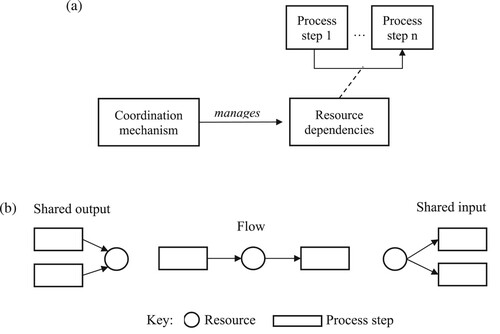
The theory distinguishes resource dependencies: ‘flow’, ‘shared input’ and ‘shared output’, which require different coordination mechanisms. ‘Flow’ dependency implies that the resource must be produced when needed (issued notification for the consumer), usable (e.g. standardised, tested), and available for a consumer (i.e. transferred to the consumer). ‘Shared input’ stipulates that two or more actors require the same resource, and someone must prioritise resource allocation. Finally, ‘shared output’ happens when two or more actors collectively develop a resource. A coordination mechanism for this dependency is either (a) to pick one activity or (b) to arrange iterations between these activities (once activities add value to the product), as depicted in Figure b.
2.3. Ontology as a model and contract for collaborations
Process taxonomies and ontologies can structure design knowledge and resolve unmanaged or partially managed dependencies (Crowston Citation1997; Malone and Crowston Citation1994). Ontologies are formal representations of conceptualisations of domains of interest; conceptualisation is an abstract, simplified view of some knowledge we wish to capture (Greco et al. Citation2004; Gruber Citation1995). A typical ontology consists of typed objects (nodes) and properties (links), where the meaning is explicit and enables reuse, revolutionising how large organisations utilise and share their data (Noy et al. Citation2019). An advantage of formal semantics is that it enables automated reasoning: (1) Determines whether an ontology is consistent and fits the guidelines and (2) Infers additional information based on the axioms that define the ontology. Semantic technologies increase software quality and reusability by eliminating the programming logic needed for semantic processing and inferencing from being hardwired into application software code. By deriving knowledge from the domain, the specification of the production process can be automated (Greco et al. Citation2004; Rajsiri et al. Citation2008) to conceptualise manufacturing resource exchange of plants (Lin et al. Citation2011), simulate logistics (Jiang, Peng, and Liu Citation2010), or even whole supply chain management (Yan et al. Citation2010).
2.4. Research gap and contribution
Semantic and knowledge-based technologies, such as ontologies and automated reasoning for distributed decision support across multiple local instances, support a promising way to create a collaboration process between firms on demand and resolve coordination problems. By applying knowledge-based tools, we can manage the complexity of production networks, transforming conventional buyer-supplier contracts into flexible, demand-driven sourcing relationships (Benitez, Ayala, and Frank Citation2020; Schmidt et al. Citation2021).
However, previous works partially explore these ideas, not including ontology implementation and the corresponding process assembly system guided by ontology (Dourish et al. Citation1996; Vanderfeesten, Reijers, and Van der Aalst Citation2011). The established ontologies in the manufacturing domain focus on integrating cross-organisational systems; however, to our knowledge, they mainly deal with encoding pre-defined collaboration process structures. Therefore, the research efforts have yet to develop the notion of ontology-guided demand-driven collaborations fully. By deriving resource exchange across manufacturing supply chains (Lin et al. Citation2011), the proposed approach derives resource dependencies between the process steps to construct and coordinate process execution. This solution can also simulate collaborative processes involving alternative team compositions (Jiang, Peng, and Liu Citation2010), spanning several supply chain tiers or across supply chains (Yan et al. Citation2010). Ontology-guided coordination could help firms better react to market demands (Horváth and Szabó Citation2019) and utilise capacities in the case of disruptions.
Our solution also contributes to potential standardisation efforts aimed at cross-company processes and data exchanges focusing on industrial collaborations (Müller, Veile, and Voigt Citation2020). Furthermore, due to the need to support the efforts of the ontological community, such as IOF, in developing a supply chain domain ontology, we propose our approach as a generic mechanism that can be incorporated into any supply chain ontology for converting classes and properties describing material flows into a process ready for execution in the workflow engine.
3. Methodology
3.1. Research context
The findings reported in this paper originate from research conducted in the context of a large-scale Industry 4.0 digital manufacturing project funded by the European Union under the Horizon 2020 research and innovation programme (grant agreement no. 723336) to help small innovative suppliers to integrate into aerospace supply chains and traditional industrial processes. The DIGICOR (Decentralised Agile Coordination Across Supply Chains) projectFootnote9 involved a consortium of 11 organisations from Germany, the Netherlands, Greece, the United Kingdom, the Czech Republic, and Italy, encompassing an Association of Aerospace SMEs (AAS) and a significant aerospace corporation (MAC). The goal of DIGICOR was to develop an open platform, tools, and services for the setup and coordination of production networks to facilitate the collaborative integration of non-traditional yet innovative SMEs into the supply chain of large manufacturers (OEMs). The main production scenario driving the development of an ontology-guided approach involved low-volume and high-variability manufacturing of highly complex products such as modules of commercial aircraft. These outputs are further developed in the ─ EFPF (European Connected Factory Platform for Agile Manufacturing).Footnote10
For requirements management, we used the following data collection techniques: (i) paper-and-pencil interviews with 17 CEOs of SMEs representing a spectrum of aviation and space-oriented service SMEs; (ii) in-depth interviews with two industrial experts from MAC and AAS, who had more than 20 years of experience in the aerospace industry; (iii) presentations with discussions during the leading experts in aerospace manufacturing (e.g. project workshops 2017–2019 in Prague, Hamburg and Brussels); (iv) participation in the round tables organised by AAS and MAC at the world’s leading event for airlines and aerospace supply chains, such as ‘International Supplier Expo Aircraft Interiors 2018-2019. All data was transcribed from the audio recording of the meeting. We used thematic analysis, a qualitative method, to find common themes in the dataset (Braun and Clarke Citation2006). The analysis of data and requirements unveiled barriers impeding data sharing and coordination between SMEs as significant roadblocks to demand-driven collaboration (Kazantsev et al. Citation2022), which could be improved by collaboration process support, as shown in Table .
Table 1. The thematic analysis (excerpt) about coordination barriers (Kazantsev et al. Citation2022).
We used these three barriers to guide the design goals for developing an ontology to support coordination between the firms. Notably, the high costs of data interchange with customers (Barrier 1) suggest the need for shared processes between suppliers enabling interoperability and information sharing and reducing the time needed to establish data exchanges in a demand-driven collaboration. Creating such an environment can also respond to Barrier 2 by increasing the ability to utilise partners’ data, awareness, and earlier mitigation of risks. Finally, Barrier 3 may be resolved by enforcing interoperability between the firms engaged in demand-driven collaborations.
3.2. Research method
The design science research method (DSRM) (Hevner Citation2007; March and Smith Citation1995) from the Information Systems field was followed to develop the research artefacts and findings reported in this paper. DSRM is gaining popularity in the operations and supply chain fields of study due to its methodological support for constructing processes and optimisation approaches. DSRM is suitable when developing an equally valuable artefact for research and practice (Gregor and Hevner Citation2013; Hevner Citation2007). DSRM advocates for multiple iterations with the end-users informed by theoretical underpinnings, which reduces the mismatch between designed artefacts and end users’ expectations for functionality and quality. DRSM (March and Smith Citation1995) directed the research steps addressing the proposed research question and facilitated the construction of purposeful artefacts – the approach, the ontology, and the process assembly and inference engine implemented using SWRL rules to form a collaboration process. During the research method execution, we often switched between collecting production requirements (relevance cycle), elicited in collaboration with the aerospace SME cluster and investigating the gaps and theoretical underpinnings for our designs (design cycle) in the extant literature (rigour cycle). The main research steps are positioned as cycles, depicted in Figure :
The Relevance cycle collected requirements from the EU-funded project DIGICOR (2016-2019) for developing an ontology-guided approach. Requirements for the ontology have been analysed, and reuse has been sought from existing ontologies. We started with the early experimentation with available top-level ontologies but then realised the need to develop a solution that could be incorporated into any ontology with classes and properties specifying processes and resources. Mainly, we built upon the Enterprise Ontology (Uschold et al. Citation1998), the Collaboration Ontology (CO) (Mehandjiev, Stalker, and Carpenter Citation2008), the ontology for small series production by (Inden et al. Citation2013, 158) and the Process model ontology (DeBellis and Neches Citation2022, 1062). We extended the ontology for small series production by (Inden et al. Citation2013, 158) by incorporating process steps, resources and SWRL rules. We drafted an interactive dashboardFootnote11 to engage with the SME cluster managers to explain the interface of the solution and get feedback. The assembly design inherited features from the Supply Chain Operational Reference (SCOR/DCOR) model, especially embedding the key Level-1 processes.
The Design cycle enabled the iterative development of the ontology-guided approach. Using coordination theory (Malone and Crowston Citation1994), we asserted input and output resources as properties for each process step, not the sequence between the steps per se. (This contrasts with the former ontology (DeBellis and Neches Citation2022), which directly mapped the ‘Next’ property between two process steps, making connections static). We made several iterations of ontology development (as part of the design cycle), including validating the ontology with the end users. This validation guaranteed that the ontology requirements were met and that the ontology-guided approach to supporting coordination answered the RQ, making process formation and coordination flexible and dynamic. Thus, the proposed artefacts addressed a real business problem – how to support demand-driven collaborations in production (Kazantsev et al. Citation2022).
Comparison with the established ontologies: To show the advantages of our design and compare it with extant literature, we identified only one comparable ontology for a similar domain, proposed by (Inden et al. Citation2013); however, this ontology does not allow the construction of a coordination process via reasoning. In contrast, our ontology constructs a sequence of steps using resource dependencies between process steps, a unique contribution to flexibility in B2B collaborations. The proposed ontology described in this paper extends earlier work on mapping semantic links to process steps (DeBellis Citation2019) by incorporating constructs derived from coordination theory;
Checking for inconsistencies: The authors completed a Bunge-Wand-Webber checklistFootnote12, one of the most popular methods for constructing valid ontologies (Lukyanenko Citation2020). OWL has formal semantics, a decidable subset of First Order Logic (FOL); therefore, we checked for logical inconsistencies using an automated reasoner (DeBellis and Neches Citation2022). In addition, we used one of the ontology testing tools called the OntOlogy Pitfall Scanner (OOPS)Footnote13,Footnote14 (Poveda-Villalón, Gómez-Pérez, and Suárez-Figueroa Citation2014), which is a tool capable of identifying ‘anti-patterns’, i.e. these issues may indicate the ontology does not follow accepted best practices, and that the reasoner will not catch (DeBellis and Neches Citation2022). For example, through OOPS, we found that there was a need for an Open Source licence on the ontology (therefore, the CCA 4.0 licence was added). Other minor changes included prefixes, domains or ranges for object properties, data properties, and redundant superclass removal;
Data (ontology) sharing: we uploaded the ontology to Web ProtegeFootnote15 and enabled link sharing, so anyone with a link can access the inferred version and provide feedback. The ontology was shown at the thematic session devoted to ‘Ontology-Based Development of Industrial Systems’ at the MIM 2022 conference and was highlighted by the session's chairs – experts in aerospace ontology engineering.
Receiving feedback from the industry: From the words of the SME cluster managers, We drafted a collaborative tendering in BPMN and compared our ontology-guided results to the suggested one, removing the algorithm so that it derives the correct elements.Footnote16
The Rigour cycle used the notion of resource allocation as a basis for coordinating process execution (Crowston Citation1997), which provided a theoretical foundation for this study. Our design allows process steps to be dynamically configured by specifying resources needed for their coordination. We resolved resource dependencies by applying coordination mechanisms and facilitating demand-driven collaborations. Iterations with the existing literature and domain knowledge (rigour cycle) enabled us to fill gaps in the theory, as illustrated in Figure .
Figure 4. Design Science process, adapted from (Hevner Citation2007).
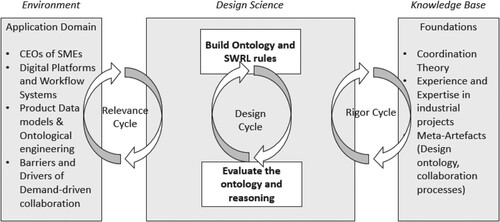
4. Findings
The suggested ontology-guided approach consists of four steps. First, the product and process specifications are derived from the Bill of Materials and the Bill of Processes. They are asserted as classes and properties of the collaboration ontology, which builds on product assembly requirements, process steps, input/output resources, and semantic rules. Second, the semantic module interprets resource requirements as suggested links between process steps. Third, the semantic links between the process steps are interpreted as a potential process by converting the chunks of classes connected into the BPMN notation. The control flows, and logical junctions (AND, XOR) are specified based on resource dependencies. Fourth, the newly generated process is uploaded to a workflow engine. Figure a shows the conceptual model of the proposed approach.
Figure 5. a. The conceptual model of an ontology-guided approach to process formation. b. The technical model of an ontology-guided approach to process formation. The grey blocks reflect ontological parts, and the blue areas – are process parts. A process is derived from the resource dependencies to deliver a product, as guided by ontology. The figure shows the technical model of an ontology-guided approach to process formation, that interconnects the bill of materials via ontology to process formation and execution. c. A flowchart of how the ontology can ‘operationalise’ product delivery. The figure shows a flowchart of ontology operationalising product delivery.
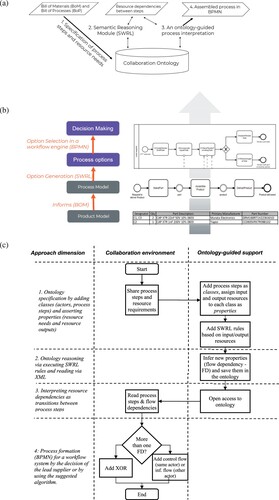
Figure b shows a technical model of how the Bill of Materials is used in the ontology to derive a process in the BPMN notation. Specifically, we show the ontological layers (left) that indicate the abstraction levels of these changes. The right part shows that the table (Bill of Materials) is fed to the ontology, structured as Make-Assemble-Deliver classes, and derives a process for the team selected to fulfil a manufacturing order. This proposed approach is closely related to the SCOR model and supports demand-driven collaborations between supply chain members.
Figure c displays an algorithm referring to guidance that the ontology provides for a collaboration process between firms, represented as an entity of the Actor class. The Process steps can be asserted to actors, thus, creating conditions for a process formation. The algorithm's outcome (an assembled BPMN process) can be executed in major workflow engines.
4.1. Dimension 1: ontology specification: classes and properties
First, following the Supply Chain Operation Reference model (SCOR), we divided the Bill of Processes into three process steps sub-classes:
MakePart process steps have no input resources and can trigger process formation. Their outputs (parts) are inputs to AssembleProduct processes.
AssembleProduct process steps consume input resources (parts or products) and produce output resources (product), thus iteratively developing the product.
DeliverProduct process step consumes the ordered product (per BoM/BoP) as an input resource and ensures product transfer to the customer according to procurement specifications and quality checks.
hasInputResource specifies resource needs (input) per each process.
hasOutputResource specifies the outputs of each process.
4.2. Dimension 2: ontology specification: SWRL functions to infer resource dependencies
In contrast to the asserted properties added manually, the SWRL functions automatically add new properties between the process steps (classes) by checking the resource dependency between the steps (e.g. flow, shared input, or shared output). Thus, the inferred properties are derived from the ontology based on the asserted connections.
The first SWRL rule (1) infers the hasFlowDependency between two process steps – ‘?TaskA’Footnote17, producing a resource and ‘?TaskB’, requiring the produced ‘?resource’. However, due to the Open-world assumption, OWL does not assume that two objects are different unless there is some axiom that implies they must be. Therefore, we specify that for hasFlowDependency, process steps need to be distinct (differentFrom):

The second SWRL rule derives how the ontology supports inference on the process steps towards iteratively developing the shared output (hasSharedOutput- i.e. indicates a need to predefine the number of iterations for developing the product by two or more process steps). For example, the code below indicates two process steps, ‘?taskA’ and ‘?taskB’ engaged in the iterative development of the same resource?draft into the property hasSharedOutput:

The third SWRL rule indicates process steps simultaneously calling for the same resources. Since these process steps compete for the same resource; therefore, the resource needs to be prioritised for one of the process steps (symmetric property hasSharedInput):

4.3. Dimension 3: interpreting resource dependencies as process transitions
The inferred resource dependencies could be used to construct a process. For example, hasFlowDependency points to the next possible activity that uses the produced resource. At the same time, other properties (hasSharedOutput, hasSharedInput) indicate the need for a decision which can be made manually by a collaboration facilitator or by using Artificial Intelligence. Several possible process steps allow the process owner to decide (e.g. agree, disagree) and optionality for the next step (e.g. sending the tender by post or email). The Collaboration ontology with inferred properties (orange dashed links) is illustrated in Figure . Grey-coloured links represent the asserted properties.
Figure 6. Classes and properties of an experimental ontology: asserted properties hasInputResource\hasOutputResource, inferred property:hasFlowDependency.
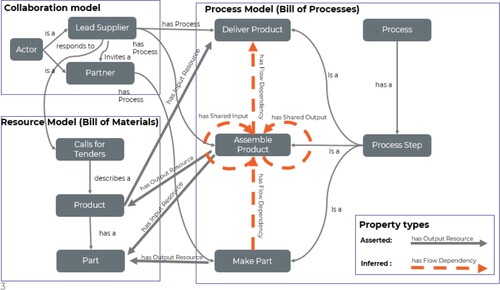
For example, we used a formation of a new collaborative tendering process between the actors: The Lead supplier and the Invited partner. Lead suppliers can form teams on the collaboration platforms (Cisneros-Cabrera et al. Citation2021; Liu et al. Citation2022), yet they cannot manually coordinate how to write collaborative tender documentation. The lead supplier receives Calls for tender (as an input resource), prepares a tender draft (output resource), receives input from the partner on the tender, incorporates the input, ensures that the partner agrees with the documentation, and if it is agreed, then submits tender. Finally, the Invited partner provides input to the tender and votes for tender submission. If the Invited partner disagrees with the tendering document, the Lead supplier invites an alternative partner.
In order to arrange these steps into a sequence, all individuals (process steps) were asserted to the collaboration ontology, which infers new semantic relationships (sequences between process steps), Figure . The bold yellow links indicate the inferred property ‘hasFlowDependency’, which was identified between ‘t1CreateTenderDraftTask’ and ‘t222MakeInputTask’, based on resource interdependencies, and indicates a potential transition (sequence) between these steps. The purple connection line indicates the instances of a class/subclass, while the yellow dashed line exemplifies the inferred property ‘hasFlowDependency’.
4.4. Dimension 4: BPMN visualisation and execution in a workflow engine
We developed a web tool in JAVA that derives actors, process steps, and the inferred properties from the ontology and, using the algorithm (Figure c), visualises the BPMN diagram for a workflow editor, Figure . The new inferred properties ‘hasFlowDepenedency’ suggest the potential sequences between the process steps belonging to a Lead supplier or Invited partner; therefore, all process steps are arranged by their resource dependencies. For example, if there are two ‘hasFlowDependency’ between the process steps, the XOR element is added, inviting the process owner to make a selection.
Figure 8. The derived BPMN process of collaborative tendering.Footnote18
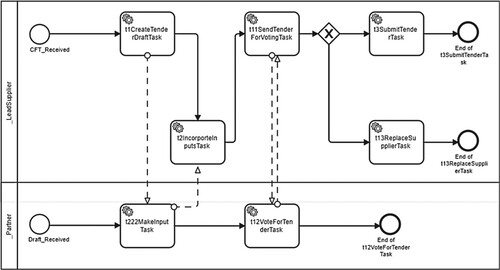
Unlike conventional static process management approaches, ontology-guided coordination enabled actors, process steps and resource dependencies from the ontology to visualise the process based on the resource demand of each step. In addition, the ontology-guided approach allowed for the process's dynamic formation, which can adjust each time the resource requirements change, thus ensuring flexible process design and coordination of demand-driven collaboration. Finally, the process can be quickly updated for three or more actors or replace steps until the resource requirements are met.
5. Discussion and conclusion
The work reported in this paper advances production research in approaches and tools to facilitate demand-driven collaborations. We propose semantic constructs and reasoning mechanisms to interconnect suppliers and facilitate their collaborative work on tendering documents or awarded manufacturing orders. Furthermore, where the existing pool of suppliers cannot complete the order and external suppliers are needed, our semantic approach can enable demand-driven collaborations with new partners, which is a timely and essential contribution to collaborative industrial engineering.
Ontologies represent a conceptualisation of the real-world products and relationships representing companies’ capabilities, CfT requirements, and other concepts essential for forming and maintaining supply-chain collaborations. The ontology-guided approach provides interoperability among SME suppliers from different domains once their processes and resources are included in the shared ontology. It increases SME readiness to collaborate on demand (Perks et al. Citation2017), thus supporting the work to reduce ripple effects (Dolgui, Ivanov, and Sokolov Citation2018). We provide the ontological underpinning of a demand-driven collaboration, which allows engaging small and medium-sized enterprises into negotiation whilst forming a flexible collaboration process model. We focus on a new way to build a collaboration process, using input and output resource requirements of each process step, rather than the strict sequential dependency common in workflow and process management tools (Jensen Citation2013; Van Der Aalst, Van Hee, and van Hee Citation2004). This paper tackles the research question: ‘How to support demand-driven collaboration using semantic technologies for manufacturing process formation and coordination. In the process of addressing the RQ, we have taken the following steps:
Designed the collaboration ontology for forming on-demand collaborations and described its application in natural production settings, where resource dependencies between processes of different levels mediate the formation and coordination of demand-driven collaborations (Kazantsev et al. Citation2022).
Conceptualised and designed the ontology-guided collaboration approach, where three classes arrange process steps: (MakePart, AssembleProduct and DeliverProduct). The ontology-guided approach supports the agile process formation required in Industry 4.0 supply network scenarios (Ivanov et al. Citation2020; Moeuf et al. Citation2018) and supports the creation of collaborative production processes on the fly that suppliers could use without any collaboration facilitator (De Vreede and Briggs Citation2019).
Articulated a real-world application of Coordination Theory constructs (Malone and Crowston Citation1994) in product assembly in a demand-driven collaboration. We implemented the constructs into the ontology for production research, encompassing process steps and properties. It enables forming production processes based on resource dependencies, enabling more flexibility during execution.
5.1. Managerial and policy implications
Our ontology constructs a coordinated production process using semantic reasoning, a unique contribution contrasting us from available manufacturing ontologies. At any point in the process, the ontology provides the relevant information either to the orchestrator (e.g. lead supplier) for manual decision-making or to the workflow engine (e.g. digital tool) for automated decision-making based on resource needs. The information from the ontology is critical to enabling a flexible process model for a team of suppliers, which allows replacing partners and rearranging steps until the resource requirements are satisfied. Our approach differs from other process formation methods, which are predefined and unable to support the dynamic formation of teams. In contrast, ontology-guided digital tools can enable a new generation of workflow systems.
The proposed ontology-guided approach allows the reconfiguration of processes based on resource requirements and coordination mechanisms to manage resource interdependencies. Notably, we argue that the derived resource dependencies have an advantage over the static assignment of the following steps, as the coordination via resources enables flexibility and dynamics for process formation and reconfiguration. Furthermore, it enables dynamic connections between process steps and adds options for process designers. Our paper shows a scenario that applies a collaboration ontology with predefined classes, properties, and SWRL rules for facilitating and better structuring demand-driven collaborations. The collaboration ontology has shown practical relevance in underpinning the Industry 4.0 digital collaboration platform DIGICOR by embracing the concepts required for collaborative manufacturing in Industry 4.0, such as goal, value-added activity, resource and dependency, ontology-guided semantic reasoning, and decision-making supporting the selection of teams and operationalisation goals. The proposed approach enables flexible collaboration process formation complying with formalised coordination constraints. This provides an essential addition to process management systems research, arguing for using resource-based rather than solely sequence-based dependencies for connecting process steps. The resource-based design features enable flexibility for collaborative process construction. Based on feedback from SME cluster members from our consortium that evaluated our approach, reducing collaboration barriers using semantic technologies will facilitate the setup of new (nascent) collaborations and widen business opportunities.
5.2. Limitations and future work
The limitations of our approach include testing the ontology within the aerospace domain, which implies gaps in validation with other production sectors (e.g. automotive or food manufacturing). Furthermore, we did not deploy the ontology in a large-scale production setting to test scalability and run-time performance. Finally, our work was mainly confined to collaboration process assembly to tackle production goals in the bill of materials of manufacturing tenders.
Future work will explore the potential of ontological relationships and axioms to support collaboration optimisation. For example, automated inference about the notion of ‘best teams’ based on different strategic priorities, such as fastest delivery, highest customer satisfaction score, and best alignment to sustainability standards. We plan to utilise more of the Semantic Web, especially the SPARQL language, which enables access to large, open, reusable knowledge graphs like dbpedia.org. In addition, it can derive Product and process composition alternatives, exploring the relationships between parts and products and the suitability of prospective suppliers for fulfilling specific tasks the best way. The data properties might be used to calculate the processing time, CO2 emissions and other metrics valuable for process managers in the production environment. Finally, agile process management, which implies multiple iterations between the actors (in contrast to linear delivery), is another exciting opportunity for ontology-guided process formation and coordination, specifically relevant to distributed large-scale crowdsourcing projects.
The authors thank Dr Zixu Liu for the early java experiment on creating BPMN elements from the ontology, that was later developed into the tool used in the paper. The first author appreciates the feedback on the presented ontology from his colleagues: Dr Giovanna Martinez Arellano, Dr Karol Niewiadomski (University of Nottingham) and Dr Davide d’Amico (University of Cranfield).
Data availability statement
Disclosure statement
No potential conflict of interest was reported by the author(s).
Additional information
Funding
Notes on contributors

Nikolai Kazantsev
Nikolai Kazantsev is a postdoctoral research associate at the Institute for Manufacturing (IfM), University of Cambridge. Nikolai is passionate about preparing manufacturing systems (such as healthcare, aerospace, food) before the next disruption, such as pandemics, war or climate disaster. The particular issue of Nikolai’s concern are complex socio-technical issues, such as demand-driven collaborations, data sharing, and stress testing of manufacturing systems. Nikolai received his PhD from the Alliance Manchester Business School, The University of Manchester, after the dissertation ‘Supporting SME collaborations in low-volume high-variability manufacturing’. His postgraduate research was supported by the EU-funded project DIGICOR, Zoetis – the largest animal health company, The Engineering and Physical Sciences Research Council. Nikolai holds an Early Career Researcher (ECR) Fellowship at InterAct – a Made Smarter Innovation funded, Economic and Social Research Council-led network and is affiliated with Clare Hall College, Cambridge.

Michael DeBellis
Michael DeBellis is an independent consultant and researcher. He has done significant work with artificial intelligence and software engineering in both industry and research. He was the principal investigator and leader of the Knowledge Based Software Assistant group funded by the USAF at Accenture’s Centre for Strategic Technology Research (CSTaR). He was a partner at Deloitte Consulting where he ran a solution centre lab in San Francisco and was one of the leaders of Deloitte’s eBusiness practice. He was vice president in charge of the Western Region for Thoughtworks, the leading US consulting firm for agile methods and advanced technology. Currently his focus is on the Semantic Web. He does consulting for clients and research in applications of the Semantic Web to cognitive science and other domains. More information can be found at his web site: https://www.michaeldebellis.com/ and he can be reached at [email protected]

Qudamah Quboa
Qudamah Quboa received a PhD in Information Systems - Business and Management from the University of Manchester, United Kingdom, in 2020. He is a research fellow with the Data Visualisation Observatory at the University of Manchester. His research interests include knowledge representation, Immersive visualisation, Immersive analytics, and Virtual environment.

Pedro Sampaio
Pedro Sampaio is a Senior Lecturer (Associate Professor) in Information Systems and Data Science at The University of Manchester. Dr. Sampaio has published extensively in the fields of Information Systems, Data Science, Industry 4.0, and Artificial Intelligence. He has also developed Knowledge Reports for McKinsey & Company's Internal Knowledge Research Practice. Dr. Sampaio has led and participated in research/consulting projects involving academic and business organisations in the United Kingdom, Continental Europe, Latin America, and the United States in the Construction, Telecom, Banking, and IT industries. Dr. Sampaio's research has been funded by the European Commission (H2020 and FP7) Programmes, Innovate UK, EPSRC (Case Award), The Alan Turing Institute, SMEs in the United Kingdom, and by Brazil's National Research Council (CNPq), Brazil's Special Training Programme (PET/CAPES) and Sao Paulo's State Research Council (FAPESP). Dr. Sampaio holds a Ph.D. in Computer Science from the University of Manchester.

Nikolay Mehandjiev
Nikolay Mehandjiev researchers approaches and models which enable non-technical audience to understand, adopt and control complex systems. Examples of such complex systems include service-based systems and systems based on artificial intelligence including intelligent advisors and industrial robots. A current focus of investigation is the use of immersive visualisations for understanding and controlling data analytics and artificial intellience applications. An example of a key result based on earlier work and embodied in mature research software is a recursive model linking goals and processes involved in setting up and coordinating the work of dynamic collaborative organisations. The research is grounded in the actual needs of blue-chip industrial partners, including Airbus, Unilever, BT, Comau, SAP and Atos Origin.

Iain Duncan Stalker
Iain Duncan Stalker currently looks after the MBA programmes at the Greater Manchester Business School, University of Bolton. Iain has previously worked at the University of Manchester, University College London (UCL), University of Leeds, ETH-Zurich, and the Teesside University. Iain’s research interests relate to Intelligent Software Systems, Distributed Artificial Intelligence, Business Model Innovation, and Collaborative Design and Manufacture.
Notes
1 https://cordis.europa.eu/project/id/723336 (accessed 27 April 2023)
2 https://cordis.europa.eu/project/id/825075 (accessed 27 April 2023)
3 https://www.hanse-aerospace.net/de/ueber-uns/mitglieder (accessed 27 April 2023)
4 W3C OWL 2.0 Specification https://www.w3.org/TR/owl2-overview/ (accessed 22.12.2022)
5 The implementation of the proposed ontology-guided approach in JAVA is available on GitHub for reproducibility, reuse, and further research https://github.com/QudamahAMBS/coordinationtheory.engine (accessed 03/04/2023)
6 https://ontocommons.eu (accessed 27 April 2023)
7 https://industrialontologies.org (accessed 27 April 2023)
8 https://industrialontologies.org/supply-chain-wg/ (accessed 27 April 2023)
9 EU-funded project DIGICOR https://cordis.europa.eu/project/id/723336, accessed 01.07.2022
10 EU-funded project EFPF https://cordis.europa.eu/project/id/825075, accessed 27.04.2023
11 https://balsamiq.cloud/stg4ncg/p6vz06b (accessed 23.12.2022)
12 https://digitaltwinhub.co.uk/top-level-ontologies/bunge-wand-webber-ontology-r39/ (accessed 24.12.2022)
13 https://ideas.repec.org/a/igg/jswis0/v10y2014i2p7-34.html (accessed 24.12.2022)
14 https://oops.linkeddata.es/ (accessed 24.12.2022)
15 https://webprotege.stanford.edu/#projects/0ef007e9-4229-433d-b6ef-9bb63f9e1a79/edit/Classes (accessed 30.03.2023, registration in Protégé is required)
16 https://cawemo.com/share/8ee81e38-ddc2-4a9c-a824-83819a4ac6a3 (accessed 24.12.2022)
17 ‘?var’ is a convention to indicate variables or missing parts of data, that needs to be found from a tender specification (e.g. bill of materials, bill of processes)
18 This JAVA implementation is available on GitHub for reproducibility, reuse, and further research https://github.com/QudamahAMBS/coordinationtheory.engine (accessed 03/04/2023)
References
- Arista, R., F. Mas, D. Morales-Palma, and C. Vallellano. 2022. “Industrial Resources in the Design of Reconfigurable Manufacturing Systems for Aerospace: A Systematic Literature Review.” Computers in Industry 142: 103719. https://doi.org/10.1016/j.compind.2022.103719.
- Arista, R., F. Mas, D. Morales-Palma, and C. Vallellano. 2023. “An Ontology-Based Engineering Methodology Applied to Aerospace Reconfigurable Manufacturing Systems Design.” International Journal of Production Research, https://doi.org/10.1080/00207543.2023.2217296.
- Arista, R., X. Zheng, J. Lu, and F. Mas. 2023. “An Ontology-Based Engineering System to Support Aircraft Manufacturing System Design.” Journal of Manufacturing Systems 68: 270–288. https://doi.org/10.1016/j.jmsy.2023.02.012.
- Benitez, G. B., N. F. Ayala, and A. G. Frank. 2020. “Industry 4.0 Innovation Ecosystems: An Evolutionary Perspective on Value Cocreation.” International Journal of Production Economics 228 (107735): 1–13. https://doi.org/10.1016/j.ijpe.2020.107735.
- Bernhard, J., M. Peters, J. Janke, J. Starke, U. Jessen, B. Odenthal, P. Miehlke, et al. 2007. Abschlussbericht - AerViCo - Aufbau eines Virtuellen Unternehmens in der Luft- und Raumfahrt (BMBF Förderkennzeichen 01HU0160-01HU0169).
- Braun, V., and V. Clarke. 2006. “Using Thematic Analysis in Psychology.” Qualitative Research in Psychology 3 (2): 77–101. https://doi.org/10.1191/1478088706qp063oa.
- Briggs, R. O., G. L. Kolfschoten, G.-J. de Vreede, S. Lukosch, and C. C. Albrecht. 2013. “Facilitator-in-a-Box: Process Support Applications to Help Practitioners Realize the Potential of Collaboration Technology.” Journal of Management Information Systems 29 (4): 159–194. https://doi.org/10.2753/MIS0742-1222290406.
- Chen, D., G. Doumeingts, and F. Vernadat. 2008. “Architectures for Enterprise Integration and Interoperability: Past, Present and Future.” Computers in Industry 59 (7): 647–659. https://doi.org/10.1016/j.compind.2007.12.016.
- Cisneros-Cabrera, S., G. Pishchulov, P. Sampaio, N. Mehandjiev, Z. Liu, and S. Kununka. 2021. “An Approach and Decision Support Tool for Forming Industry 4.0 Supply Chain Collaborations.” Computers in Industry 125: 103391–16. https://doi.org/10.1016/j.compind.2020.103391.
- Crowston, K. 1997. “A Coordination Theory Approach to Organizational Process Design.” Organization Science 8 (2): 157–175. https://doi.org/10.1287/orsc.8.2.157.
- Crowston, K., J. Rubleske, and J. Howison. 2015. “Coordination Theory: A ten-Year Retrospective.” In Human-Computer Interaction and Management Information Systems: Foundations, 134–152. Routledge.
- D’Amico, R. D., J. A. Erkoyuncu, S. Addepalli, and S. Penver. 2022. “Cognitive Digital Twin: An Approach to Improve the Maintenance Management.” CIRP Journal of Manufacturing Science and Technology 38: 613–630. https://doi.org/10.1016/j.cirpj.2022.06.004.
- DeBellis, M. 2019. Semantic Web Rule Language (SWRL) Process Modeling Tutorial. https://www.michaeldebellis.com/post/swrl_tutorial (accessed 27.04.2023).
- DeBellis, M., and R. Neches. 2022. “Knowledge Representation and The Semantic Web: An Historical Overview of Influences on Emerging Tools.” Recent Advances in Computer Science and Communications 15.
- De Vreede, G.-J., and R. O. Briggs. 2019. “A Program of Collaboration Engineering Research and Practice: Contributions, Insights, and Future Directions.” Journal of Management Information Systems 36 (1): 74–119. https://doi.org/10.1080/07421222.2018.1550552.
- Dolgui, A., D. Ivanov, and B. Sokolov. 2018. “Ripple Effect in the Supply Chain: An Analysis and Recent Literature.” International Journal of Production Research 56 (1-2): 414–430. https://doi.org/10.1080/00207543.2017.1387680.
- Dourish, P., J. Holmes, A. MacLean, P. Marqvardsen, and A. Zbyslaw. 1996. “Freeflow: Mediating Between Representation and Action in Workflow Systems.” Proceedings of the 1996 ACM Conference on Computer Supported Cooperative Work.
- EY. 2020. COVID-19: How to Build Supply Chains Resilient to Disruption. https://www.ey.com/en_gl/consulting/how-to-build-a-supply-chain-thats-resilient-to-global-disruption (accessed 27.04.2023).
- Greco, G., A. Guzzo, L. Pontieri, and D. Saccà. 2004. “An Ontology-Driven Process Modeling Framework.” In Database and Expert Systems Applications. DEXA 2004. Lecture Notes in Computer Science, edited by F. Galindo, M. Takizawa, and R. Traunmüller, Vol. 3180, 13–23. Springer.
- Gregor, S., and A. R. Hevner. 2013. “Positioning and Presenting Design Science Research for Maximum Impact.” MIS Quarterly, 337–355. https://doi.org/10.25300/MISQ/2013/37.2.01.
- Gruber, T. R. 1995. “Toward Principles for the Design of Ontologies Used for Knowledge Sharing?” International Journal of Human-Computer Studies 43 (5-6): 907–928. https://doi.org/10.1006/ijhc.1995.1081.
- Hevner, A. R. 2007. “A Three Cycle View of Design Science Research.” Scandinavian Journal of Information Systems 19 (2): 4.
- Horváth, D., and R. Z. Szabó. 2019. “Driving Forces and Barriers of Industry 4.0: Do Multinational and Small and Medium-Sized Companies Have Equal Opportunities?” Technological Forecasting and Social Change 146: 119–132. https://doi.org/10.1016/j.techfore.2019.05.021.
- Inden, U., N. Mehandjiev, L. Mönch, and P. Vrba. 2013. “Towards an Ontology for Small Series Production.” In Industrial Applications of Holonic and Multi-Agent Systems, 128–139. Springer.
- Ivanov, D., A. Das, and T. Choi. 2018. “New Flexibility Drivers for Manufacturing, Supply Chain and Service Operations.” International Journal of Production Research 56 (10): 3359–3368. https://doi.org/10.1080/00207543.2018.1457813.
- Ivanov, D., A. Dolgui, and B. Sokolov. 2019. “The Impact of Digital Technology and Industry 4.0 on the Ripple Effect and Supply Chain Risk Analytics.” International Journal of Production Research 57 (3): 829–846. https://doi.org/10.1080/00207543.2018.1488086.
- Ivanov, D., C. S. Tang, A. Dolgui, D. Battini, and A. Das. 2020. “Researchers’ Perspectives on Industry 4.0: Multi-Disciplinary Analysis and Opportunities for Operations Management.” International Journal of Production Research 59 (7): 1–24.
- Janke, J., J. Starke, J. Bernhard, U. Jessen, M. Peters, B. Odenthal, P. Miehlke, et al. 2007. Handlungsleitfaden zum Aufbau und Betrieb eines Virtuellen Unternehmens in Luft- und Raumfahrt (AerViCo - Aerospace Virtual Company), Issue.
- Jensen, K. 2013. Coloured Petri Nets: Basic Concepts, Analysis Methods and Practical Use (Vol. 1). Springer Science & Business Media.
- Jiang, Y., G. Peng, and W. Liu. 2010. “Research on Ontology-Based Integration of Product Knowledge for Collaborative Manufacturing.” The International Journal of Advanced Manufacturing Technology 49 (9): 1209–1221. https://doi.org/10.1007/s00170-009-2463-3.
- Kagermann, H., J. Helbig, A. Hellinger, and W. Wahlster. 2013. Recommendations for Implementing the Strategic Initiative INDUSTRIE 4.0: Securing the Future of German Manufacturing Industry (Industrie 4.0 Working Group, Issue).
- Kazantsev, N. 2022. Supporting SME Collaborations in Low-Volume High-Variability Manufacturing. United Kingdom: The University of Manchester.
- Kazantsev, N., G. Pishchulov, N. Mehandjiev, P. Sampaio, and J. Zolkiewski. 2022. “Investigating Barriers to Demand-Driven SME Collaboration in low-Volume High-Variability Manufacturing.” Supply Chain Management: An International Journal 27 (2): 265–282. https://doi.org/10.1108/SCM-10-2021-0486.
- Kazantsev, N., P. Sampaio, G. Pishchulov, S. Cisneros Cabrera, Z. Liu, and N. Mehandjiev. 2018. A Governance Metamodel for Industry 4.0 Service Collaborations.
- Kazantsev, N., I. D. Stalker, N. Mehandjiev, and P. Sampaio. 2022. “Ontology-based Collaborative Assembly in the Low-Volume High-Variability Manufacturing.” IFAC-PapersOnLine 55 (10): 2707–2712. https://doi.org/10.1016/j.ifacol.2022.10.119.
- Knoll, S. W., T. Plumbaum, J. L. Hoffmann, and E. W. De Luca. 2010. “Collaboration Ontology: Applying Collaboration Knowledge to a Generic Group Support System.” In Group Decision and Negotiation Meeting (GDN) 2010.
- Kolfschoten, G. L., and G.-J. De Vreede. 2009. “A Design Approach for Collaboration Processes: A Multimethod Design Science Study in Collaboration Engineering.” Journal of Management Information Systems 26 (1): 225–256. https://doi.org/10.2753/MIS0742-1222260109.
- Lee, J., G. M. Wyner, and B. T. Pentland. 2008. “Process Grammar as a Tool for Business Process Design.” MIS Quarterly, 757–778. https://doi.org/10.2307/25148871.
- Lin, L., W. Zhang, Y. Lou, C. Chu, and M. Cai. 2011. “Developing Manufacturing Ontologies for Knowledge Reuse in Distributed Manufacturing Environment.” International Journal of Production Research 49 (2): 343–359. https://doi.org/10.1080/00207540903349021.
- Liu, Z., P. Sampaio, G. Pishchulov, N. Mehandjiev, S. Cisneros-Cabrera, A. Schirrmann, F. Jiru, and N. Bnouhanna. 2022. “The Architectural Design and Implementation of a Digital Platform for Industry 4.0 SME Collaboration.” Computers in Industry 138: 103623. https://doi.org/10.1016/j.compind.2022.103623.
- Lukyanenko, R. 2020. “A Journey to BSO: Evaluating Earlier and More Recent Ideas of Mario Bunge as a Foundation for Information Systems and Software Development.” In Enterprise, Business-Process and Information Systems Modeling, 345–358. Springer.
- Machado, C. G., M. P. Winroth, and E. H. D. Ribeiro da Silva. 2020. “Sustainable Manufacturing in Industry 4.0: An Emerging Research Agenda.” International Journal of Production Research 58 (5): 1462–1484. https://doi.org/10.1080/00207543.2019.1652777.
- Malone, T. W., and K. Crowston. 1990. “What is Coordination Theory and How Can it Help Design Cooperative Work Systems?” Proceedings of the 1990 ACM Conference on Computer-Supported Cooperative Work.
- Malone, T. W., and K. Crowston. 1994. “The Interdisciplinary Study of Coordination.” ACM Computing Surveys 26 (1): 87–119. https://doi.org/10.1145/174666.174668.
- March, S. T., and G. F. Smith. 1995. “Design and Natural Science Research on Information Technology.” Decision Support Systems 15 (4): 251–266. https://doi.org/10.1016/0167-9236(94)00041-2.
- Mehandjiev, N. D., I. D. Stalker, and M. R. Carpenter. 2008. “Recursive Construction and Evolution of Collaborative Business Processes.” International Conference on Business Process Management.
- Mittal, S., M. A. Khan, D. Romero, and T. Wuest. 2018. “A Critical Review of Smart Manufacturing & Industry 4.0 Maturity Models: Implications for Small and Medium-Sized Enterprises (SMEs).” Journal of Manufacturing Systems 49: 194–214. https://doi.org/10.1016/j.jmsy.2018.10.005.
- Moeuf, A., R. Pellerin, S. Lamouri, S. Tamayo-Giraldo, and R. Barbaray. 2018. “The Industrial Management of SMEs in the era of Industry 4.0.” International Journal of Production Research 56 (3): 1118–1136. https://doi.org/10.1080/00207543.2017.1372647.
- Moghaddam, M., and S. Y. Nof. 2018. “Collaborative Service-Component Integration in Cloud Manufacturing.” International Journal of Production Research 56 (1-2): 677–691. https://doi.org/10.1080/00207543.2017.1374574.
- Müller, J. M., J. W. Veile, and K.-I. Voigt. 2020. “Prerequisites and Incentives for Digital Information Sharing in Industry 4.0 – An International Comparison across Data Types.” Computers & Industrial Engineering 148: 106733. https://doi.org/10.1016/j.cie.2020.106733.
- Noy, N., Y. Gao, A. Jain, A. Narayanan, A. Patterson, and J. Taylor. 2019. “Industry-scale Knowledge Graphs: Lessons and Challenges: Five Diverse Technology Companies Show how It’s Done.” Queue 17 (2): 48–75.
- Olsen, T. L., and B. Tomlin. 2020. “Industry 4.0: Opportunities and Challenges for Operations Management.” Manufacturing & Service Operations Management 22 (1): 113–122. https://doi.org/10.1287/msom.2019.0796.
- Panetto, H., B. Iung, D. Ivanov, G. Weichhart, and X. Wang. 2019. “Challenges for the Cyber-Physical Manufacturing Enterprises of the Future.” Annual Reviews in Control 47: 200–213. https://doi.org/10.1016/j.arcontrol.2019.02.002.
- Perks, H., C. Kowalkowski, L. Witell, and A. Gustafsson. 2017. “Network Orchestration for Value Platform Development.” Industrial Marketing Management 67: 106–121. https://doi.org/10.1016/j.indmarman.2017.08.002.
- Poveda-Villalón, M., A. Gómez-Pérez, and M. C. Suárez-Figueroa. 2014. “OOPS! (OntOlogy Pitfall Scanner!).” International Journal on Semantic Web and Information Systems 10 (2): 7–34. https://doi.org/10.4018/ijswis.2014040102.
- Rajsiri, V., J.-P. Lorré, F. Bénaben, and H. Pingaud. 2008. “Collaborative Process Definition Using an Ontology-Based Approach.” Working Conference on Virtual Enterprises.
- Rossen, A., F. Schlitte, S. Schulze, and A. Wolf. 2015. Volkswirtschaftliche Aspekte des Luftfahrtforschungsprogramms des BMWi.
- Sampath, A., and S. Hegde. 2013. Interoperability challenges in automotive embedded software (0148-7191).
- SCE, SCEI. 2017. Supply Chain Excellence in the German Aerospace Industry. ICE: Initiative Supply Chain Excellence. Retrieved 15.12.2021 from https://www.german-aerospace.de/wp-content/uploads/2015/08/2017_07_25-Studie-SCE-2017-EN.pdf.
- Schirrmann, A., and C. Drat. 2018. D6.1: Collaboration rules & procedures specification. Retrieved 16.12.2021 from https://6c97d07e-2d66-4f14-9c19-8c5872c4c3ba.filesusr.com/ugd/2512a7_da7dba0ebb164182803d70e03fe6773b.pdf.
- Schmidt, M.-C., J. W. Veile, J. M. Müller, and K.-I. Voigt. 2021. “Ecosystems 4.0: Redesigning Global Value Chains.” The International Journal of Logistics Management 32 (4): 1124–1149. https://doi.org/10.1108/IJLM-03-2020-0145.
- Schweichhart, K. 2016. Reference Architectural Model Industrie 4.0 (RAMI 4.0).
- Smit, J., S. Kreutzer, C. Moeller, and M. Carlberg. 2016. Industry 4.0 – study for the ITRE Committee. E. Parlament.
- Tang, C. S., and L. P. Veelenturf. 2019. “The Strategic Role of Logistics in the Industry 4.0 Era.” Transportation Research Part E: Logistics and Transportation Review 129: 1–11. https://doi.org/10.1016/j.tre.2019.06.004.
- Turkina, E., A. Van Assche, and R. Kali. 2016. “Structure and Evolution of Global Cluster Networks: Evidence from the Aerospace Industry.” Journal of Economic Geography 16 (6): 1211–1234.
- Uschold, M., M. King, S. Moralee, and Y. Zorgios. 1998. “The Enterprise Ontology.” The Knowledge Engineering Review 13 (1): 31–89. https://doi.org/10.1017/S0269888998001088.
- Van Der Aalst, W., K. M. Van Hee, and K. van Hee. 2004. Workflow Management: Models, Methods, and Systems. MIT press.
- Vanderfeesten, I., H. A. Reijers, and W. M. Van der Aalst. 2011. “Product-based Workflow Support.” Information Systems 36 (2): 517–535. https://doi.org/10.1016/j.is.2010.09.008.
- Yan, J., K. Ye, H. Wang, and Z. Hua. 2010. “Ontology of Collaborative Manufacturing: Alignment of Service-Oriented Framework with Service-Dominant Logic.” Expert Systems with Applications 37 (3): 2222–2231. https://doi.org/10.1016/j.eswa.2009.07.051.

